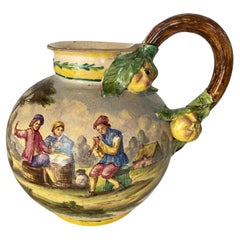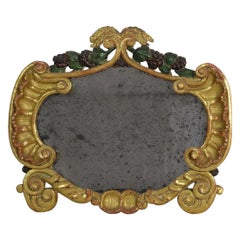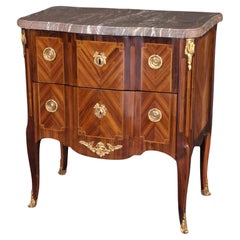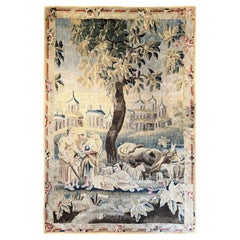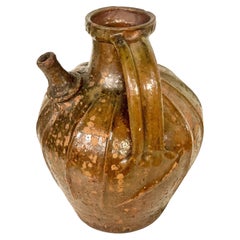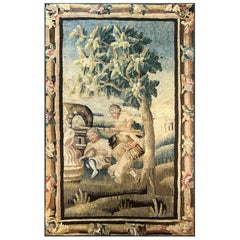France
to
279
2,661
19,968
12,459
50,671
39,822
25,084
21,729
16,516
10,439
7,684
6,756
6,458
4,702
4,341
3,904
3,505
2,934
2,816
2,772
2,661
2,202
2,157
1,671
1,141
926
886
763
744
705
698
588
525
493
473
360
356
289
176
164
151
142
125
101
94
83
52
50
49
47
43
42
35
35
27
27
26
14
13
12
10
8
7
7
3
3
73
66
50
40
20
Period: 18th Century
Genuine Faience Vase Green Red and Yellow Color Lille 1757 Decor signed Tesniers
Located in Auribeau sur Siagne, FR
Vase in Faience, in a Green red and yellow color. With a beautiful Glaze. It has been made in France in 1757 in Lille.
It is signed Lille 1757.
The decor is painted in the style of T...
Category
18th Century French French Provincial Antique France
Materials
Sandstone
Small 18th Century, Italian Carved Giltwood Baroque Mirror
Located in Buisson, FR
Beautiful carved giltwood Baroque mirror, with its original foxed mirror glass.
Italy, circa 1750. Weathered and minor losses.
Category
18th Century Italian Baroque Antique France
Materials
Giltwood
Transition Commode Stamped Jean-baptiste II Tuart
By Jean-Baptiste I. Tuart
Located in BARSAC, FR
Jean-Baptiste II Tuart is the son of Jean-Bapstiste I Tuart, one of the cabinetmakers supplying the Court under Louis XV. Trained by his father with whom he worked for a time, he the...
Category
1760s French Louis XV Antique France
Materials
Marble, Bronze
1106, 18th Century Aubusson Tapestry
Located in Paris, FR
1106 - a very beautiful 18th century Aubusson tapestry with very pretty color.
Category
1790s French Aubusson Antique France
Materials
Wool
18th C. Large Glazed Terracotta Walnut Oil Jug with Two Side Handles
Located in LA CIOTAT, FR
A large and very handsome glazed terracotta walnut oil jug, dating from the 18th century and originating from the south of France. Featuring two side handles and a single pouring spo...
Category
18th Century French Antique France
Materials
Earthenware, Terracotta
Aubusson Tapestry Bakery Scene - 18th Century - n° 1153
Located in Paris, FR
Aubusson Tapestry Bakery Scene - 18th Century
Thanks to our Restoration-Conservation workshop and also Our know-how,
we are pleased to present to you works of art in fabric such as ...
Category
1750s French Aubusson Antique France
Materials
Wool
2-door High Buffet Decor Faux Marbre
Located in PARIS, FR
This exquisite 18th-century Italian buffet is a remarkable example of the art of faux marble painting, a technique in which Italian artisans excelled. With meticulous craftsmanship, ...
Category
18th Century Italian Baroque Antique France
Materials
Wood
Gold, Enamel and Tablet Case
Located in Paris, FR
Flat trapezoidal shaped tablet case in enamelled gold. The upper part is hinged and opens with a push-button. The case is composed of four translucent blue...
Category
1790s Swiss Antique France
Materials
Gold, Enamel
Greenery tapestry Flanders Oudenaarde - 18th century Dim 2.42x2.52 - No. 1346
By Aubusson Manufacture
Located in Paris, FR
specialized in the Purchase, Sale, Traditional Cleaning, Restoration - Conservation, Expertise - Estimation of Old and also Contemporary Tapestries, Carpets, Kilims and Textiles. We ...
Category
1760s French Aubusson Antique France
Materials
Wool, Silk
Pair of 18th Century Italian Neoclassical Altar Candleholders
Located in Buisson, FR
Unique and large pair of neoclassical altar candleholders with traces of their original silver and gold,
Italy, circa 1760-1780. Weathered, small l...
Category
18th Century Italian Neoclassical Antique France
Materials
Wood
Two royal portraits (the Duc d'Angoulême and the Duc de Berry) by H.P. Danloux
Located in PARIS, FR
These two royal portraits are a major historical testimony to the stay of the Comte d'Artois (the future Charles X) and his family in Edinburgh in 1796-1797. Given by the sitters to Lord Adam Gordon, the Governor of Edinburgh, and kept by family descent to this day, these two portraits provide us with a vivid and spontaneous image of the Duc d’Angoulême and his brother the Duc de Berry. Danloux, who had emigrated to London a few years before, demonstrate his full assimilation of the art of British portrait painters in the brilliant execution of these portraits.
1. Henri-Pierre Danloux, a portraitist in the revolutionary turmoil
Born in Paris in 1753, Henri-Pierre Danloux was first a pupil of the painter Nicolas-Bernard Lépicié (1735 - 1784) and then, in 1773, of Joseph-Marie Vien (1716 - 1809), whom he followed to Rome when, at the end of 1775, Vien became Director of the Académie de France. In Rome he became friends with the painter Jacques-Louis David (1748 - 1825).
Returning to France around 1782, he settled in Lyon for a few years before returning to Paris in 1785. One of his first portraits was commissioned by the Baroness d'Etigny, the widow of the former Intendant of the Provinces of Gascony, Bearn and Navarre Antoine Mégret d'Etigny (1719 – 1767). He then became close to his two sons, Mégret de Sérilly and Mégret d'Etigny, who in turn became his patrons. In 1787, this close relationship with the d'Etigny family was further strengthened by his marriage to Antoinette de Saint-Redan, a relative of Madame d'Etigny. After his marriage, he left for Rome and did not return to France until 1789. It was during the winter of 1790-1791 that he painted one of his masterpieces, the portrait of Baron de Besenval. Set in a twilight atmosphere, this portrait of an aristocrat who knows that his death is imminent symbolizes the disappearance of an erudite and refined society which would be swept away by the French Revolution.
The Jacobin excesses led Danloux to emigrate to England in 1792; many members of his family-in-law who remained in France were guillotined on 10 May 1794. Danloux enjoyed great success as a portrait painter in England before returning to France in 1801.
During his stay in England, Danloux was deeply under the influence of English portraitists: his colors became warmer (as shown by the portrait of the Duc d'Angoulême that we are presenting), and his execution broader.
2. Description of the two portraits and biographical details of the sitters
The Duc d'Angoulême (1775-1844) was the eldest son of the Comte d'Artois, the younger brother of King Louis XVI (the future King Charles X), and his wife Marie-Thérèse of Savoie. He is shown here, in the freshness of his youth, wearing the uniform of colonel-general of the "Angoulême-Dragons" regiment.
He is wearing the blue cordon of the Order of the Holy Spirit, which was awarded to him in 1787, and two decorations: the Cross of Saint-Louis and the Maltese Cross, as he was also Grand Prior of the Order of Malta.
Born on 16 August 1775 in Versailles, Louis-Antoine d'Artois followed his parents into emigration on 16 July 1789. In 1792, he joined the émigrés’ army led by the Prince de Condé. After his stay in Edinburgh (which will be further discussed), he went to the court of the future King Louis XVIII, who was in exile at the time, and in 1799 married his first cousin Marie-Thérèse Charlotte of France, the daughter of Louis XVI and the sole survivor of the royal family. The couple had no descendants. He became Dauphin of France in 1824, upon the accession to the throne of his father but played only a minor political role, preferring his military position as Grand Admiral. Enlisted in Spain on the side of Ferdinand VII, he returned home crowned with glory after his victory at Trocadero in 1823.
He reigned for a very short time at the abdication of Charles X in 1830, before relinquishing his rights in favor of his nephew Henri d'Artois, the Duc de Bordeaux. He then followed his father into exile and died on 3 June 1844 in Gorizia (now in Italy).
His younger brother, the Duc de Berry, is shown in the uniform of the noble cavalry of the émigrés’ Army. He is wearing the blue cordon of the Order of the Holy Spirit, awarded to him in May 1789, and the Cross of Saint-Louis (partly hidden by his blue cordon).
Born on 24 January 1778 in Versailles, Charles-Ferdinand d'Artois also followed his parents into emigration and joined the émigrés’ army in 1792. After his stay in Edinburgh, he remained in Great Britain, where he had an affair with Amy Brown...
Category
1790s Old Masters France
Materials
Canvas, Oil, Wood Panel
Large 18th Century Italian Hand Carved Giltwood Baroque Curl Ornament
Located in Buisson, FR
Beautiful and large handcarved giltwood baroque ornament that once adorned a chapel or a church.
Italy, circa 1750. Weathered/ small losses. Measurement includes the wooden base.
H:6...
Category
18th Century Italian Baroque Antique France
Materials
Wood
A changing taffeta Embroidered Frockcoat - French Revolution period Circa 1790
Located in Toulon, FR
Circa 1790
France
Adorned ( homme paré) man's silk frockcoat dating from the French Revolution period. Yellow-green silk taffeta with pink shading (green warp and pink weft). Frac a...
Category
1790s French France
Letter S - Etching by Luigi Vanvitelli - 18th Century
Located in Roma, IT
Letter S is an Etching realized by Luigi Vanvitelli.
The etching belongs to the print suite “Antiquities of Herculaneum Exposed” (original title: “Le Antichità di Ercolano Esposte”)...
Category
Late 18th Century Old Masters France
Materials
Etching
Large Grand Tour 18th Century Capriccio Painting Roman Ruins after Gennaro Greco
Located in Cotignac, FR
A fine, large 18th century veduta capriccio scene with temple ruins after Gennaro Greco from the circle of Pietro Cappelli. The painting is presented in a more modern carved gilt woo...
Category
18th Century Baroque France
Materials
Oil, Canvas
Nice Collection of 18th/ 19th Century Weathered Spanish/ Italian Vellum Books
Located in Buisson, FR
Nice collection of four extremely weathered vellum books, Spain/ Italy 18th / 19th century. Weathered and small losses
Measures: H:15-24cm W:1,5-5,5cm D:10,5-17cm
Measurements her...
Category
18th Century Spanish Antique France
Materials
Parchment Paper
Pair of Roccoco swedish chairs with lion paws feet & balustrade shaped backrest
Located in PARIS, FR
This striking pair of Swedish baroque chairs, circa 1800, embodies the elegance and grandeur of 18th-century design. With their bold lion’s paw feet and finely sculpted baluster back...
Category
18th Century Swedish Rococo Antique France
Materials
Wood
18th Century Mercury Mirror from France
Located in Lyon, FR
Charming mirror from the end of the 18th century, France.
Hand-carved wood, original mercury glass, recognizable thanks to its "sparkly" effect, particularly remarkable on the edges ...
Category
Late 18th Century French Louis XVI Antique France
Materials
Mercury Glass, Wood
Large Sculptural Italian Baroque Tabernacle Frame, Late 18th Century
Located in Aramits, Nouvelle-Aquitaine
An impressive, large Italian Baroque tabernacle hand carved frame from the late 18th century,
which reflects the Renaissance influence of Classical Greek and Italian temples with its columns on both sides and the embellishment of the piece through the carved putti on the top, a typical element of the Baroque style. The religious plaster relief has been added at a later moment. Tabernacle frames...
Category
Late 18th Century Italian Baroque Antique France
Materials
Walnut
Macbeth and the Three Witches a Painting on Panel by Francesco Zuccarelli
By Francesco Zuccarelli
Located in PARIS, FR
This painting, created during Zuccarelli's stay in England, represents the decisive moment when Macbeth, together with Banquo, meets the three witches who announce that he will be Ki...
Category
1760s Old Masters France
Materials
Oil, Wood Panel
French Large Louis XV Period Wardrobe Provencal Richly Carved 18th - France
Located in Beuzevillette, FR
Rare Provencal cabinet from the Louis XV period, richly carved with foliage and plant motifs: bouquets, bunches of grapes, ears of wheat... The legs are curved and finished with a sc...
Category
18th Century French Louis XV Antique France
Materials
Wood
18th C. Glazed Nut Oil Jar with Three Handles from Dordogne Region
Located in LA CIOTAT, FR
A tall and shapely antique walnut oil jug, originating from the Dordogne region of France, fully glazed in a rich and glossy golden brown, and further embellished with multiple appli...
Category
18th Century French Antique France
Materials
Terracotta
Le Lapin Sauvage - Etching by Jacques De sève - 1771
Located in Roma, IT
Le Lapin Sauvage is an artwork realized by Jacques de Seve in 1771.
Etching B./W. print on ivory paper. Signed on plate on the lower left margin.
The work is glued on cardboar...
Category
1770s Modern France
Materials
Etching
Statue sculpture life size antique old Roman Greek stone reclaimed carving decor
Located in Costa Mesa, CA
Antique statue life sized Roman Greek natural stone old sculpture.
The antique statue displayed in this Ad is one of 12 reclaimed life sized limestone statues.
In this specific ...
Category
Early 18th Century French Rustic Antique France
Materials
Limestone
Night Thoughts - Rare Book Illustrated by Sir William Blake - 1797
By William Blake
Located in Roma, IT
Night Thoughts is an original Modern Rare book written by Edward Young (1683 – 1765) and engraved by Sir William Blake (London, 1757 - London, 1827) in 1797.
It includes a suite of ...
Category
1790s Modern France
Materials
Paper, Etching
Suite of Four Jacob Frères Chairs
By Jacob Freres Rue Meslée
Located in Paris, FR
Suite of Four Jacob Frères Chairs, circa 1796.
In the neoclassical style.
Category
Late 18th Century French Neoclassical Antique France
Materials
Wood
Pair of stone flower baskets
Located in SAINT-OUEN-SUR-SEINE, FR
This pair of stone sculptures made in the mid-18th century represents a woven basket filled with flowers, fruits and plants.
Among the element...
Category
18th Century French Louis XIV Antique France
Materials
Stone
French Table Provincial Oak and Beech Top Server Dining Table 18th Century
Located in Labrit, Landes
French table made in the 18th century French Provincial
This type of table had a triple function:
- it could be used to store flour and knead bread (which is why the top can be rem...
Category
Mid-18th Century French French Provincial Antique France
Materials
Oak, Beech
Louis XVI - Original French 18th Century Sterling Silver Salt Cellars & Mustard
By France"
Located in Wilmington, DE
Direct from a chateau in the south of France, a magnificent privately commissioned, 18th century 7pc table set of gorgeous original Louis XVI salt cellars (2 double and 4 single) and...
Category
Late 18th Century French Louis XVI Antique France
Materials
Sterling Silver
Italian 18/19th Century Hand Carved Giltwood Acanthus Leaf Ornament
Located in Buisson, FR
Beautiful handcarved giltwood acanthus leaf ornament that once adorned a chapel . Original period piece that due its high age has a beautiful weathered look.
Italy circa 1780/1850 , ...
Category
18th Century Italian Antique France
Materials
Wood
Armoire Bordelaise In Mahogany
Located in BARSAC, FR
Elegant 18th-century armoire Bordelaise in solid mahogany. Opening two large doors, decorated with fluting, "gendarme hat" cornice molded with boudins and ogee. Cremone bolt and t...
Category
Mid-18th Century French Louis XVI Antique France
Materials
Mahogany
Beautiful Antique 18th Century Aubusson Tapestry
Located in Saint Ouen, FR
Very beautiful 18th century French Aubusson tapestry with beautiful design and beautiful with red, blue and green, entirely handwoven at Aubusson manufacturing with wool and silk wov...
Category
Late 18th Century French Aubusson Antique France
Materials
Wool
French 18th Century Small Marble Head Of A Madonna
Located in Buisson, FR
Beautiful hand carved marble head of a Madonna.
Unique period piece with a beautiful weathered patina.
France, circa 1750.
Weathered
Measurements include the wooden base.
Category
18th Century French Antique France
Materials
Marble
View of a Mansion in the South of France, a drawing by Claude-Joseph Vernet
By Claude-Joseph Vernet
Located in PARIS, FR
We would like to thank Madame Beck-Saiello for confirming the autograph nature of this drawing after an in-person examination.
It was probably during an excursion in the countryside near Avignon that Claude-Joseph Vernet executed this drawing, enhanced with pen and brown ink, depicting a mansion on a hilltop overlooking a small village with geometric shapes.
1. Joseph Vernet, a painter influenced by Italy
Claude-Joseph Vernet was born in Avignon in 1714, the son of Antoine Vernet (1689-1753), an artisan painter of architectural decorations, coach panels, and the like. He moved to the studio of Philippe Sauvan (1697-1792), a leading history painter in Avignon, and then worked with Jacques Viali (active 1681-1745), a decorative, landscape, and marine painter in Aix-en-Provence. Vernet's first recorded paintings were decorative overdoors executed in 1731 in the Aix townhouse of the marquise de Simiane. In 1734, Joseph de Seytres, marquis de Caumont, a leading amateur in Avignon, sponsored Vernet to make a study trip to Italy to complete his artistic education and to draw antiquities for his patron.
As Avignon was a papal territory in Vernet's day, he also had a number of useful introductions among influential churchmen when he arrived in Rome. Vernet was soon at home in the French community there, and he was encouraged by Nicolas Vleughels (1668-1737), director of the Académie de France in Rome, even though the young painter had no official affiliation with the royal institution. He likely entered the studio of the French marine painter Adrien Manglard...
Category
1730s Old Masters France
Materials
Ink, Laid Paper, Pen, Carbon Pencil
Italian Console
Located in VILLENEUVE-LÈS-AVIGNON, FR
Beautiful Italian console in cream and gold lacquer, carved wood.
18th century
painted slate top
Louis XV
Category
18th Century Italian Louis XV Antique France
Materials
Giltwood, Lacquer
18th Century Diamonds 18 Karat Rose Gold Silver Flower Brooch
Located in Poitiers, FR
Brooch in 18 karat rose gold and silver.
A lovely antique brooch representing a blooming flower with a large pear-shaped rose-cut diamond at its heart, and rose-cut diamonds at the p...
Category
18th Century French Napoleon III Antique France
Materials
Diamond, White Diamond, Gold, 18k Gold, Rose Gold, Silver, Sterling Silver
Small 18/19th Century French Giltwood Mirror With Grapes
Located in Buisson, FR
Small hand carved mirror with grapes. Unique period piece.
France, circa 1780-1850
Weathered, small , small losses.
Measurements include the wooden base.
H:38cm W:26,5cm D:9cm
Category
18th Century French Neoclassical Antique France
Materials
Wood
Rouen, Wyvern Platter "à la guivre", France 18th Century
Located in PARIS, FR
Superb Rouen wyvern platter ("à la Guivre"), 18th century France. Exquisite and rare museum quality piece. Decorations of a parrot carrying a branch, butterflies, an aquatic landscape and an Asian wyvern dragon.
These dragons are different from those found in European fairy tales and films. In China, they're in the arts, zodiac signs and festivals ("Dragon Dance" at Chinese New Year). They embody power, perseverance... Linked to the sky and water, they have meteorological powers, such as making it rain. So they often live in tumultuous rivers, at the bottom of oceans... hence the lake over which this dragon "flies". What's more, this earthenware dragon...
Category
18th Century Antique France
Materials
Ceramic
Bergère Louis XV
Located in VILLENEUVE-LÈS-AVIGNON, FR
Bergère en bois de noyer époque Louis XV, structure ondulée sculptée, dossier, pieds et accoudoirs à double courbure, assise et dos rembourrés.
Origine Italie - Gênes
XVIIIe siècle
Category
18th Century Italian Louis XV Antique France
Materials
Wood, Nutwood
Skeleton after Titian - Etching by Jean François Poletnich - 1755
Located in Roma, IT
Skeleton after Titian is an etching realized by Jean Francois Poletnich in 1755.
Signed in the plate.
Good conditions with foxing.
The artwork is depicted through confident stroke...
Category
1750s Modern France
Materials
Etching
Italian 17th/ 18th Century Baroque Carved Wooden Silverleaf Mirror With Angels
Located in Buisson, FR
Amazing 17th/ 18th century hand carved silverleaf mirror. On the sides of the mirror you can see two angel heads on baroque curls and claw feet.
Italy, circa 1650-1750, weathered, s...
Category
18th Century Italian Baroque Antique France
Materials
Wood
Antique Original Louis XVI Set of Four Period Chairs by J.B. Lelarge Paris 1775
Located in Doha, QA
An absolutely fantastic set of four original Louis XVI French armchairs made by Jean Baptiste Lelarge. All four chairs have Lelarge stamp on them . He was one of the most famous furn...
Category
18th Century French Baroque Antique France
Materials
Tapestry, Silk, Wood, Giltwood
Veduta della Basilica di San Giovanni in Laterano by G.B.Piranesi - 1749
By Giovanni Battista Piranesi
Located in Roma, IT
Veduta della Basilica di San Giovanni in Laterano, is an original etching realized by Giovanni Battista Piranesi in 1749.
S. Giovanni in Laterano with palace and Scala Santa on t...
Category
18th Century Modern France
Materials
Etching
Pair of Large Louis XV Armchairs, 18th Century
Located in BARSAC, FR
Magnificent pair of Louis XV armchairs in carved beech, queen-style backrests, whip armrests consoles, very elegantly scalloped belts carved...
Category
Mid-18th Century French Louis XV Antique France
Materials
Beech
Piranesi, Hand Coloured Period Engraving, Vue d'un Superb Palais de Rome
By Giovanni Battista Piranesi
Located in Cotignac, FR
A fine hand coloured 18th Century engraving after the original by Piranesi (Rome 1743), published by Danisy, Paris. Presented in period gold leaf frame, under glass.
Piranesi was born in Venice, in the parish of S. Moisè where he was baptised. His father was a stonemason. His brother Andrea introduced him to Latin literature and ancient Greco-Roman civilization, and later he was apprenticed under his uncle, Matteo Lucchesi, who was a leading architect in Magistrato delle Acque, the state organization responsible for engineering and restoring historical buildings.
From 1740, he had an opportunity to work in Rome as a draughtsman for Marco Foscarini, the Venetian ambassador of the new Pope Benedict XIV. He resided in the Palazzo Venezia and studied under Giuseppe Vasi, who introduced him to the art of etching and engraving of the city and its monuments. Giuseppe Vasi found Piranesi's talent was much greater than that of a mere engraver. According to Legrand, Vasi told Piranesi that "you are too much of a painter, my friend, to be an engraver."
After his studies with Vasi, he collaborated with pupils of the French Academy in Rome to produce a series of vedute (views) of the city; his first work was Prima parte di Architettura e Prospettive (1743), followed in 1745 by Varie Vedute di Roma Antica e Moderna.
From 1743 to 1747, he was mainly in Venice where, according to some sources, he often visited Giovanni Battista Tiepolo, a leading artist in Venice. It was Tiepolo who expanded the restrictive conventions of reproductive, topographical and antiquarian engravings. He then returned to Rome, where he opened a workshop in Via del Corso. In 1748–1774, he created an important series of vedute of the city which established his fame. In the meantime Piranesi devoted himself to the measurement of many of the ancient buildings: this led to the publication of Le Antichità Romane de' tempo della prima Repubblica e dei primi imperatori ("Roman Antiquities of the Time of the First Republic...
Category
Late 18th Century Baroque France
Materials
Paper, Ink, Watercolor
French 17/ 18th Century Hand Carved Oak Baroque Curl Ornament
Located in Buisson, FR
Beautiful handcarved and natural weathered oak baroque ornament . Was once part of a larger piece.
France, circa 1650-1750. Wonderful weathered condition. Measurement includes the wo...
Category
18th Century French Baroque Antique France
Materials
Oak
French Provençal sideboard in walnut - Louis XV Period - 18th century - France
Located in Beuzevillette, FR
Low sideboard in walnut fruit wood opening with two leaves and two drawers on the front, nicely molded and resting on a arched base joined by a scalloped crosspiece.
The top of the s...
Category
18th Century French Louis XV Antique France
Materials
Wood
Late 18th century Statuary and Brocatelle marble fireplace with putti
Located in SAINT-OUEN-SUR-SEINE, FR
This exceptionnal baroque fireplace is from Italy, dated as the end of the 18th century. It is an outstanding marble piece, and gathers two types of beautiful and distinct marbles; white statuary Carrara marble and Brocatelle marble, characterized by the rich and foliage patterns all over its swirling veining surface. The Carrara marble quarries found near the Mediterranean sea between Pisa and Parma, have been famous since roman times and add a distinct shine and refinement to objects carved out from this marble.
A delicate marble bust is standing in the center of the fireplace and is balancing the richly detailed white and yellow decor...
Category
18th Century Italian Antique France
Materials
Marble, Carrara Marble
18th c. French, circa 1725, by François de Troy, portrait of a Lady as Ceres
Located in PARIS, FR
18th century French School
François de Troy (1645 – 1730), Paris, circa 1725
Portrait of a Woman as the Goddess Ceres
Oil on canvas: h. 39 in, w. 31.3 in
Regen...
Category
Early 18th Century Old Masters France
Materials
Canvas, Oil
Fireback with Louis XIV monogram and French coat of arms
Located in SAINT-OUEN-SUR-SEINE, FR
This beautiful cast iron fireback made around 1700 is adorned with a rare and rich decoration.
Its shape is characteristic of the 18th century beginning, the top in an arc of a circl...
Category
18th Century French Louis XIV Antique France
Materials
Iron
Le Chat d'Angora - Etching by Louis Legrand - 1771
By Louis Legrand
Located in Roma, IT
Le Chat d'Angora is an etching realized in 1771 by ` (1723-1807).
It belongs to the suite "Histoire naturelle, générale et particulière avec la description du Cabinet du Roi".
Arti...
Category
1770s Modern France
Materials
Etching
A dazzling Venetian Regatta Boat Study attributed to Alessandra Mauro
Located in PARIS, FR
This stunning Baroque study depicts a regatta boat, a type of vessel developed in eighteenth-century Venice for the regattas organized by the Serenissima during visits by royalty and princes. We propose to link this drawing to the work of Alessandro Mauro, an artist who specialized in this type of composition, as illustrated by a drawing from him at the Metropolitan Museum.
1. Description of the boat
The greatest decorative fantasy reigns in this preparatory study, which blends mythological and exotic elements with references to ancient Egypt. Our drawing is probably an initial thought, destined to be refined and clarified later in pen and ink (as evidenced by the ink stain in the lower right). A quadriga of seahorses guided by Neptune stands at the stern of the boat, shown well above the waterline (perhaps to outline its empty volume). One of the seahorses is ridden by a newt, while Amphitrite lies at the feet of the sea god.
The center of the boat is occupied by a vast baldachin resting on four atlantes and surmounted by a figure riding an animal (a dragon?). Three figures sit beneath the canopy, one of them on a griffin-shaped seat. This allusion to Egyptian antiquity echoes the winged sun (sometimes a symbol of the god Horus, as in the temple of Edfu in Egypt) that adorns the sides of the promontory on which this baldachin rests.
Another flag-bearer figure crouches at the stern of the boat on a raised seat, on the reverse of which is a crowned mermaid whose arm, extended backwards, rests on a mascaron decorated with a radiant face (Helios?) and whose torso surmounts an elephant's head. The heads of the rowers and their oars are sketched all along the boat, whose sides are embellished with elongated naiads.
2. The Venetian regatta boats
An exhibition held in 2013 at the Ca' Rezzonico (the Venetian eighteenth-century museum) paid tribute to these regatta boats through studies and prints depicting them. The regattas organized by the Serenissima in honor of visiting princes and sovereigns were among the most spectacular ceremonies in Venice. Some important artists of the 18th century contributed to the creation of these extravagant boats which were given exotic names such as bissona, malgarota or peota.
The specialists in this field were Andrea Urbani and the brothers Alessandro and Romualdo Mauro. They were born into a family of theater decorators in Piedmont, but little is known about their detailed biography. Alessandro was the architect of the Dresden opera house and of the St. Samuel Theater in Venice (in collaboration with his brother Romualdo), but also worked as stagehand and set designer in Vienna, Rome and Turin. A drawing produced around 1737 from the Metropolitan Museum (7th photo in the gallery) bears witness to his activity as a regatta boat designer.
This drawing is a much more elaborate version than the one presented here, having been entirely reworked in brown ink. However, a figure at the bow of the boat, executed solely in black chalk, still bears witness to a technique similar to that of our drawing.
It is difficult to know whether the boat depicted in our drawing was a project for an actual boat or whether it remained in the planning stage, but the front of our boat (Neptune and the quadriga of seahorses ridden by a newt) bears several similarities to that of a parade boat depicted in the print published by Michele Marieschi entitled Regatta on the Grand Canal, between the Foscari and Balbi Palaces (last photo in the gallery). This print is dated 1741, which could confirm that our work dates from around 1740.
The area between Neptune and the quadriga that precedes him on this strange paddle-boat appears to be partially submerged, confirming that the waterline of our boat was probably intended to be much lower than the one shown in our drawing.
The Correr Museum’s collection holds one of the most important collection of engravings and drawings devoted to these specifically Venetian Baroque productions. These boats were intended to last the duration of a festival. Today, they are only documented by preparatory drawings or prints that testify to the sumptuousness of their decoration. This taste for regatta boats lasted throughout the Venetian eighteenth century, and the conception of regatta boats also attracted great masters such as Giambattista Tiepolo, Francesco Guardi or Giambattista Piranesi...
Category
Mid-18th Century Old Masters France
Materials
Chalk
Large 18th Century Italian Hand Carved Giltwood Baroque Curl Ornament
Located in Buisson, FR
Beautiful and large handcarved giltwood baroque ornament that once adorned a chapel or a church.
Italy, circa 1750. Weathered/ small losses and old repairs. Measurement includes the ...
Category
18th Century Italian Baroque Antique France
Materials
Wood
Portrait of Monsieur Aubert, a ceremonial portrait by Nicolas de Largillière
By Nicolas de Largillière
Located in PARIS, FR
Provenance :
Arnold S. Kirkeby (1901-1962)
Donated by Arnold S. Kirkeby to the Los Angeles County Museum of Art in 1955, where it remained until its sale at Sotheby's, New York on Ja...
Category
1720s Old Masters France
Materials
Oil
An 18th Century Meissen Porcelain Box, Louis XV Period.
By Meissen Porcelain
Located in Saint-Ouen, FR
An 18th century Meissen porcelain box, Louis XV period.
An 18th century Meissen porcelain box, Louis XV period, gilt brass mounting.
H: 14cm, W: 9cm, D: 9cm
Category
18th Century French Louis XV Antique France
Materials
Brass
French 18th Century Giltwood Console Table with Red Marble Top, Louis XV Period
Located in Marcq-en-Barœul, Hauts-de-France
A French Louis XV period carved wood console table with marble top from the 18th century. This French console table features a shaped veined marble top sitting over a very fine and r...
Category
1780s French Louis XV Antique France
Materials
Giltwood
Chinese Porcelain Soup Plate Blue and White from The Blue Family, 18th Century
Located in Beuzevillette, FR
Nice plate of the Compagnie des Indes dating from the Qianlong period, XVIIIth century. Blue and white porcelain soup plate. On this plate are drawn in blue ink a set of plants or we...
Category
Mid-18th Century Chinese Chinese Export Antique France
Materials
Porcelain
Italian 18/19th Century Hand Carved Giltwood Floral Ornament
Located in Buisson, FR
Beautiful handcarved giltwood floral ornament that once adorned a chapel .Original period piece that due it’s high age has a wonderful weather...
Category
18th Century Italian Antique France
Materials
Wood
Interior of the Nieuwe Kerk, Amsterdam
Located in Paris, Île-de-France
Jan Goeree (Middelburg 1670 – Amsterdam 1731)
Interior of the Nieuwe Kerk, Amsterdam (c. 1724)
Red chalk for the architecture, pen and black ink, grey wash on paper
Composition reversed in preparation for engraving
25 × 17.5 cm
Watermark: Hunting horn, Churchill 318 (dated 1724)
Provenance
Private collection, France
Context & Attribution
Trained in the studio of Gérard de Lairesse, Jan Goeree was among the finest Dutch engravers of the early eighteenth century, celebrated for his architectural views of Amsterdam. This drawing is a preparatory study for an engraving of the same subject now preserved in a major public collection. The final print—slightly larger—closely follows the reversed composition of this sheet.
Subject
In the center of the Gothic nave, five bearers carry a catafalque toward a freshly dug grave—a tribute to the naval heroes often buried in the Nieuwe Kerk. This funerary motif, familiar from Dutch painting (e.g. Emanuel de Witte, 1657), evokes the vanitas theme and the transience of earthly life.
Technical Analysis
Goeree’s use of red chalk for the architecture and ink for the figures reveals his working method: the chalk lines could be used to produce a counterproof restoring the correct orientation of the architecture, while the inked figures remained adjustable before the design was transferred to the copper plate.
Place within the Oeuvre
Drawings of church...
Category
Early 18th Century Old Masters France
Materials
Chalk, Ink
Pelle à tarte Porcelaine du Lys Royal décor Kakiemon Château de Chantilly France
By Imperial Porcelain Factory
Located in London, England
Cette pelle à tarte, provenant de la manufacture du Lys Royal, est une reproduction du célèbre décor "Kakiemon" qui orne les pièces du Château de Chantilly, daté du XVIIIe siècle en ...
Category
Late 18th Century French Neoclassical Antique France
Materials
Porcelain
